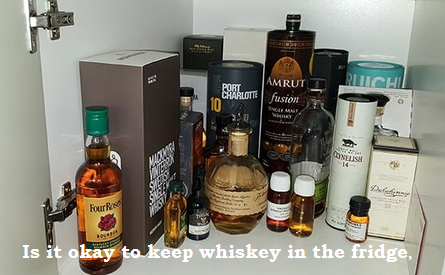
Can whisky be kept in fridge?
You can keep your whisk(e)y in the fridge, or the freezer, because since all whisk(e)y’s at minimum 40% ABV or 80 proof, the alcohol content is too high for your consumer grade freezer to freeze it.
Whisky doesn’t need to be kept in a refrigerator.
So it won’t harm the whisk(e)y, it’ll just make it cold.
However, there are a couple of things to be aware of.
Our tongues have not evolved to discern subtle nuances of flavor at extreme temperatures, hot or cold.
So if you put your whisk(e)y in the fridge or freezer, it will chill it so much that you can only taste about 60% of the whisk(e)y itself.
Related search Query
- Should whiskey be refrigerated
- can we keep vodka in fridge
- refrigerate whiskey after opening
- does alcohol go bad if you take it out of the refrigerator
- how long does whiskey last in freezer
- can you put whiskey in the freezer
- how to drink whiskey
- should whiskey be chilled
A similar thing happens if you put whisk(e)y on ice as well.
However, when you put whisk(e)y on ice, it, in addition to chilling it so much that you don’t really taste the whisk(e)y at that temperature, it’s also massively diluting it, even moreso than if you were to add water to the whisk(e)y.
Furthermore, whisk(e)y doesn’t spoil like soda, milk, juice or other beverages do, so there’s no need to chill whisk(e)y in the first place.
That’s right, whisk(e)y’s alcohol content is too high for bacteria and fungus to grow in it, generally speaking, which is why an unopened bottle of whisk(e)y doesn’t expire, and can be stored indefinitely.
So really, there’s no need to chill it in the first place.
Well, there’s really only one valid reason to store your whisk(e)y in the fridge or freezer, and that’s if you like your whisk(e)y chilled, and that’s what you prefer.
So this leaves a question unanswered.
Many of the people that read my answers about whisk(e)y, are most likely Whisk(e)y Tribe members, whisk(e)y enthusiasts, Malt Members, or just fancy themselves a connoisseur of whisk(e)y.
We like to try different things, we like to explore, we buy a bottle here and there, and over time, we amass a respectable collection of various types of whisk(e)ys.
So there’s a need to explain how to care after your collection, and after you’ve opened a few bottles.
Store Your Bottles Upright:
There’s a common misconception amongst non whisk(e)y drinkers that whisk(e)y should be stored slanted to keep the cork wet, and thus, the seal on the whisk(e)y intact.
While this works with wine, it doesn’t work with whisk(e)y because of the high alcohol content.
This works for wine and beer bottles that are corked, because we’re dealing with a drink that’s around 4–16% ABV.
Whisk(e)y, as you’ll recall, is more than double that amount of alcoholic content at 40% ABV or 80 proof, minimum.
With that high of an alcoholic content, the alcohol in the whisk(e)y will just eat and destroy that cork, ruining the seal, and thus, achieving the exact opposite of what you want.
So do the sensible thing and don’t treat whisk(e)y like wine. Treat it like whisk(e)y, and store the bottles upright.
If you are concerned about keeping the cork moist, then all you need to do with whisk(e)y is once in a while just tilt the bottle down then right back up quickly, and that’s more than sufficient to keep a whisk(e)y cork moist, and keeping the seal nice and tight.
Store Indoors at a Stable Temperature and a Cool, Dark Place:
It’s also a common misconception amongst non whisk(e)y drinkers that whisk(e)y spoils like other drinks do, and thus, needs to be stored in a fridge, or freezer.
But, whisk(e)y doesn’t spoil like milk, juice, soda, or indeed, beer and wine do.
While it won’t harm the whisk(e)y to store it in the fridge or freezer, it’s not ideal for the whisk(e)y either.
The best place to store whisk(e)y is indoors, and in a place in your home that’s removed from direct sunlight, and stays at a relatively stable temperature.
In other words, your pantry is more than sufficient for storing whisk(e)y in, and it’s perfectly fine to store whisk(e)y at room temperature. It’s actually preferred because neat pours of whisk(e)y should be served at room temperature, or slightly below.
Now, why do we want to store it away from the window or out of direct sunlight?
Because not only will sunlight discolor the whisk(e)y, and fade the label, it will also effect the tannins in the whisk(e)y, and thus, affecting the flavor, and that’s a bad thing.
Avoid Sunlight at all Costs:
Seriously, I’m mentioning this point again, because I’ve seen so many people that down whisk(e)y too quickly because they keep it on top of their fridge right in the path of direct sunlight, on top of a machine near the hottest part of the room (the ceiling).
This will directly effect the taste of the whisk(e)y in a negative way, as direct sunlight effects the tannins in whisk(e)y, and thus, ruins the flavor.
So seriously, put your bottles in a dark place. As I said, your kitchen pantry is more than sufficient.
What to Do With Opened Bottles of Whisk(e)y?:
Say you’ve opened your whisk(e)y bottle, and are worried about the flavor being effected.
Not to worry, as the cork will be your friend here.
As I said, one flip is more than sufficient to keep the cork moist, but let’s say you’re down to half of the bottle being full of whisk(e)y.
If you’re worried, I’d say buy some parafilm wax. Seal the bottle with the cap or cork, then wrap the wax film around it, and this will seal it even further.
Now, what to do when only a third of the bottle is full of whisk(e)y?
That’s the fun part. When there’s more oxygen than whisk(e)y in the bottle, this can effect the flavor quite a bit, so it’s best finished in about a month.
So drink it! Don’t rush though, you have about a few months before the flavor is effected by a tiny amount, so if there’s more air than whisk(e)y in the bottle, just finish that bottle up.
If it Came in a Tin, Check On It Once in a While:
If your whisk(e)y came in a tin, and not a cardboard box, like, for example, Laphroaig or Glenfiddich, then you want to periodically check that the bottle isn’t becoming too damp.
Cardboard boxes breathe a little more, while the tins don’t, so tin can trap in moisture, which is important if you live in a humid climate.
So every once in a while, just check up on it. If it’s getting too damp, just wipe down the bottle, and you’re good.
Here’s a couple of videos explaining how to store your whisk(e)y, one from Ralfy, at ralfydotcom, and Rex and Daniel at the Whisk(e)y Tribe.
And that’s it, really. Storing whisk(e)y isn’t as much of a pain in the neck as storing wine.
If you have a kitchen pantry, or a similar place in your home, that’s more than sufficient to store your whisk(e)y.
Just keep it out of direct sunlight, store the bottles upright, and keep them around room temperature.
But mostly, I wouldn’t worry too much. People tend to overthink whisk(e)y too much. As long as the temperature’s stable, it’s not being exposed to direct sunlight, and the bottle’s upright, it’s fine.
